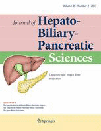Utility of augmented reality system in hepatobiliary surgery
Abstract
Background/purpose
The aim of this study was to evaluate the utility of an image display system for augmented reality in hepatobiliary surgery under laparotomy.
Methods
An overlay display of organs, vessels, or tumor was obtained using a video see-through system as a display system developed at our institute. Registration between visceral organs and the surface-rendering image reconstructed by preoperative computed tomography (CT) was carried out with an optical location sensor. Using this system, we performed laparotomy for a patient with benign biliary stricture, a patient with gallbladder carcinoma, and a patient with hepatocellular carcinoma.
Results
The operative procedures performed consisted of choledochojejunostomy, right hepatectomy, and microwave coagulation therapy. All the operations were carried out safely using images of the site of tumor, preserved organs, and resection aspect overlaid onto the operation field images observed on the monitors. The position of each organ in the overlaid image closely corresponded with that of the actual organ. Intraoperative information generated from this system provided us with useful navigation. However, several problems such as registration error and lack of depth knowledge were noted.
Conclusion
The image display system appeared to be useful in performing hepatobiliary surgery under laparotomy. Further improvement of the system with individualized function for each operation will be essential, with feedback from clinical trials in the future.




